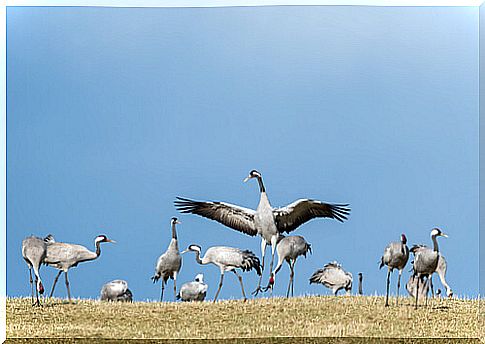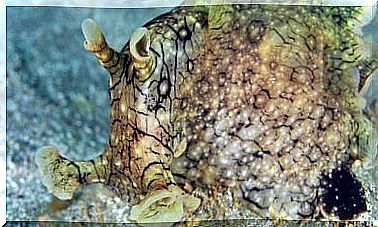Gray Heron: Characteristics, Behavior And Habitat
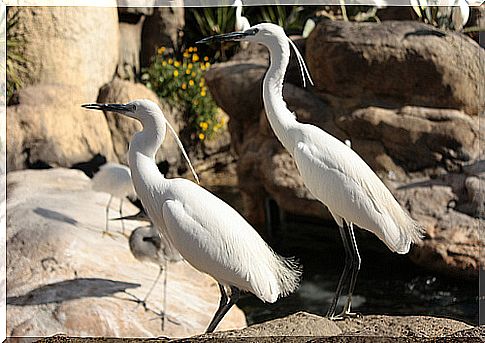
This bird with aquatic habits, from Eurasia and Africa, prefers habitats surrounded by rivers, lakes or freshwater wetlands; and it is sedentary only in temperate regions. In this article we inform you about the characteristics, behavior and habitat of the gray heron… It is truly majestic!
Characteristics of the gray heron
Its scientific name is Ardea cinerea, it is a large bird that can measure up to 10 centimeters in height, and has a large wingspan that attracts attention while in flight: from tip to tip of the wings some reach the 2 meters!
As for the plumage of the gray heron, it is characterized by the lighter grayish color on the wings and the white of the head and neck. In addition, it has a long orange or yellow beak, which is straight and ends in a point, which allows it to capture its food without problems.
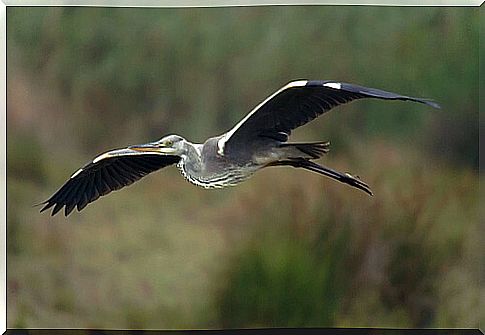
On the other hand, it is worth noting that its legs are dark and very thin, such as those of the flamingo, and that its eyes have yellow irises.
Behavior and reproduction of the gray heron
The long neck of the herons allows it to fly forming an ‘S’ between the beak and the shoulders, and this habit differentiates them from the storks and cranes, which leave the neck extended. The wingbeats are slow and can glide great distances ; sometimes they rise in circles in the air depending on how the currents and the wind develop.
In addition to spending a few hours flying, gray herons also often perch on tree branches or roam on the ground or riverbanks; in the latter situations they alternate the leg they use as support.
One of the most curious things about this bird is that to communicate with its companions it can emit different hoarse guttural sounds within the colony. In addition, the males call their mates as if it were a greeting, and they have a special sound when expelling other individuals from their nests.
Heron homes are built in trees near the banks of lakes or wetlands, although we can also find nests among reeds and bushes on the banks of rivers. The elaboration technique consists of assembling a platform of small branches, collected by the male, and lining the interior with herbs, fibers, feathers or reeds (this last task is for the female).
With regard to reproduction, it corresponds to a period between February and August and, after the greeting ceremony, where couples spread their wings in a reconnaissance flight, copulation takes place. This results in a laying of up to five eggs, which are greenish in color and incubate for 25 days.
Once the chicks hatch, the parents feed them by regurgitating their food until they are eight weeks old … Then they have to leave the nest and fend for themselves.
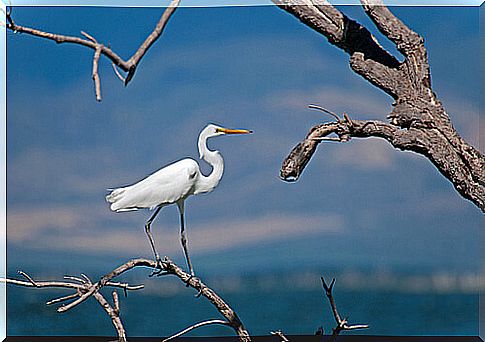
Habitat and feeding of the gray heron
The gray heron belongs to the group of pelecaniform birds, that is, it lives in lake ecosystems such as rivers, lakes and lagoons. The area of distribution includes all aquatic habitats, because it is there that it finds everything it needs, and its flight radius does not exceed 20 kilometers from the nesting site.
Although it is more frequent in low-lying areas, there are certain colonies in mountain lakes and reservoirs. Within the species of gray heron we can find four subgroups, which inhabit different places, all of them in Europe, Africa and Asia.
As for its diet, it is a carnivorous bird whose diet is based on fish, amphibians, insects and small mammals; prey that are hunted thanks to their long and sharp beaks
Regarding its hunting technique, the gray heron can fish on the prowl, both at sunrise and sunset; and it leaves its legs still in the water waiting for the ideal moment to quickly lower its neck and strike its prey.
Likewise, they swallow the whole food, without chewing and, if the pieces are larger, they hit them against the ground or pierce them with their beaks to consume them in smaller pieces.
It might interest you …
Images courtesy of: Superstringphysics, Ferran Pestaña and Carlos De Soto Molinari
